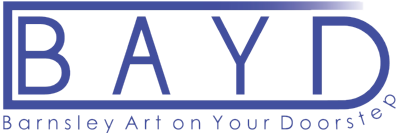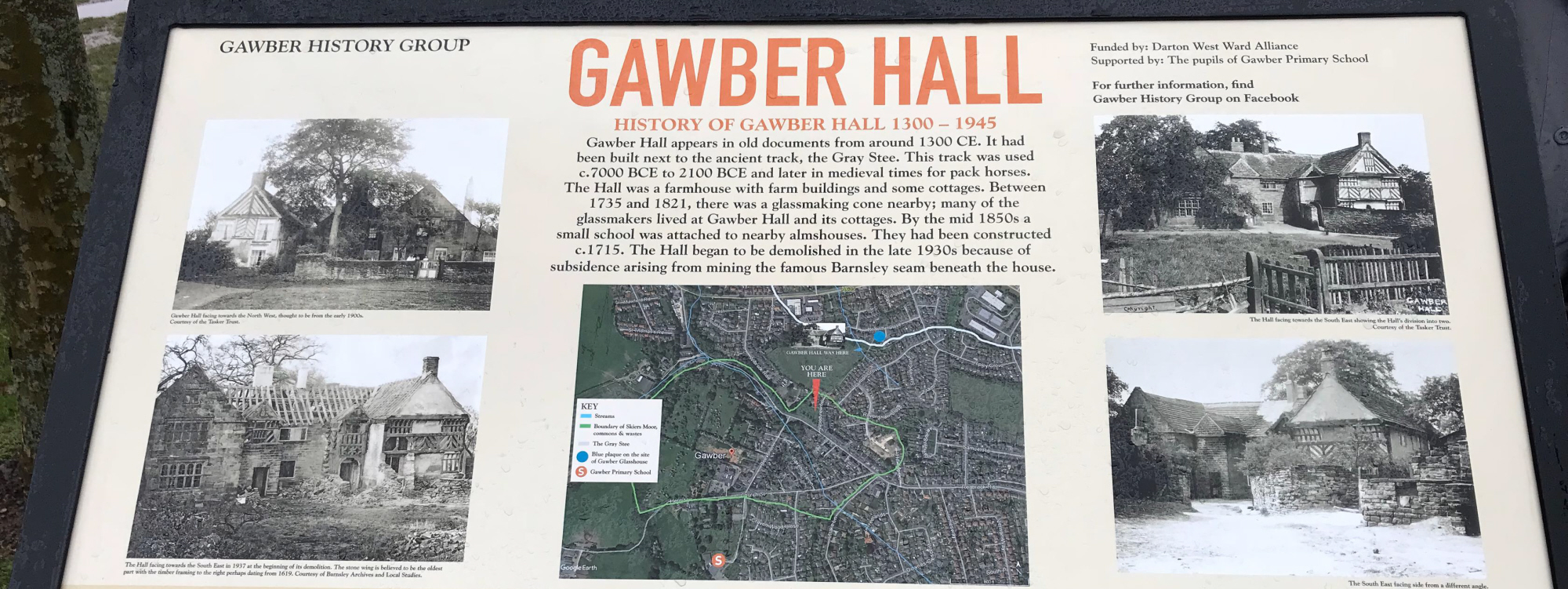
Gawber History Group
Gawber History
Historical events in Gawber, the Hidden Artists of Barnsley and Gawber History Group
One of the important legacies of our Hidden Art Project has been the 2015 creation of Gawber History Group. It was established soon after a discussion during the 2014 Hidden Art exhibition between a volunteer there and Councillor Linda Burgess who became Mayor of Barnsley for the year 2016/17. They had discussed the influence of glassmaking on these Hidden Artists of Barnsley.
Two of the hidden artists grew up at Gawber Hall. Gawber Hall was a large timber framed farm house located a few miles to the North West of Barnsley town centre. It originated from the 13th century and was improved and extended in Elizabethan and Jacobean times.
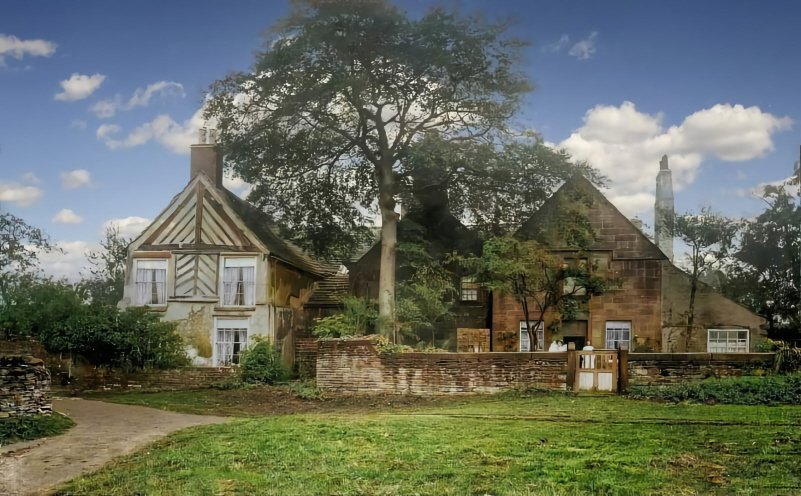
A coloured version of an early 20th century black and white photograph of Gawber Hall with thanks to Stuart J Sykes of the Facebook group ’Old Barnsley in Colour'
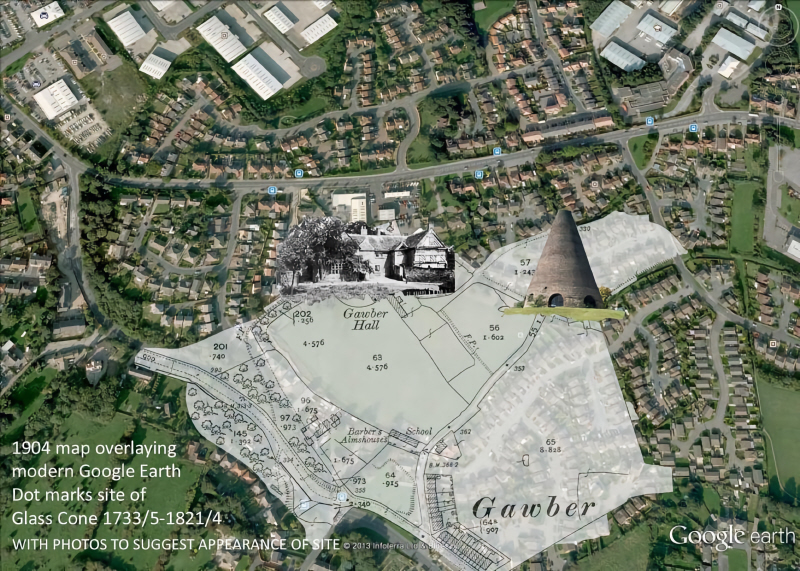
Map of Gawber from the 2014 Google Earth image with an overlay of the 1904 map from Barnsley Archives
The artists were Richard Tate, an amateur exhibiting artist and William Tate his younger brother. William became a professional artist training as a pupil of the famous artist Joseph Wright of Derby. When the brothers grew up, they soon moved to Liverpool. But in childhood, their father Paul Tate was a glassmaker at Gawber Hall Glassworks. Unusually for a glassmaker, he was there for the whole of his life. He was one of the first recorded glassmakers at Gawber. William Thorp, his uncle, had come to Gawber Hall around 1733 and married Martha Woodcock of Gawber Hall in 1735.
William Thorp, his Uncle, built the Glassworks. Other early glassmakers were William Morton and Thomas Woodcock. The full story is told in the chapter about the Tate family in our book and the chapter about Industry and Art with reference to Glassmaking.
This shows that artists have emerged from an industrial background and that artistic expression has been linked to industrial expertise.
Gawber Glassworks Animation
It was the display of an animation of Gawber Hall and its 18th century glassworks that focussed attention on the history of Gawber at the exhibition. The animation can be seen at:
Not only has Gawber Hall disappeared but so too has the Glassworks. It was only the excavation by Denis Ashurst and colleagues in the 1960s that provided evidence of a glass making cone near Gawber Hall. Through Barnsley Civic Trust and the new Gawber History Group there is now a blue plaque near the site of this cone in Redcliffe Close. The Glassworks was there between around 1735 and the following century. Glassmaking went on until 1821 after which the cone was used for various other purposes including a school room before being demolished some time before 1900. It is believed that the cone was similar in design to the one still standing at Catcliffe, Rotherham. The Catcliffe cone was built in 1740 and is one of only 4 still in existence in the United Kingdom.
The animation had been created by students from Barnsley College who were studying on the 2014 BTEC Extended Diploma in Games Design. Using the drawings from the Gawber excavation, the students used the Catcliffe glassmaking cone as a model for their DVD. Awards funded by private sponsors were given to Phoebe Jackson, Gage Bolton, Eddie Hall and Tom Price for their excellent efforts to produce such an historic DVD. The following students also contributed: Ash Jacobs, Brandon Kitchen, Tom Smith, David Brooks, Joel Beck, Brad Brown-Lang, Matt Bramley and Oliver Smedley. Huge thanks are due to everyone, to Diane Hartshorn their tutor and James Allen who have supported the students.
The glassworks had a strong reputation for ‘black‘ bottles in the late 18th century; examples of what these were like were shown in the Hidden Art of Barnsley exhibition in 2014. Denis Ashurst also found evidence of an earlier glass furnace.
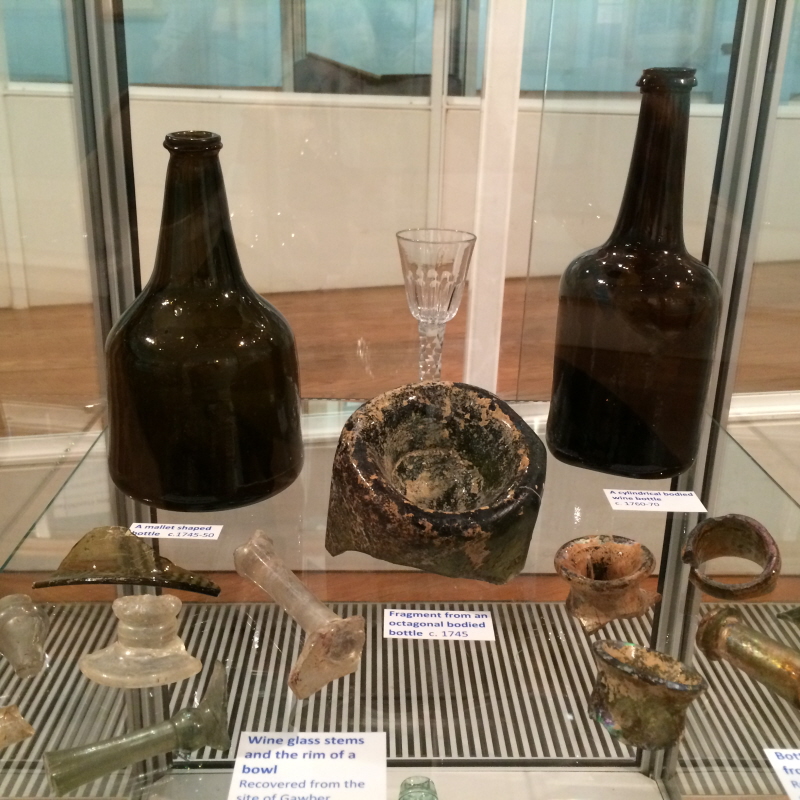
Part of the glass cabinet from the 2014 Hidden Art of Barnsley exhibition showing fragments of glass bottles from excavations in Gawber and the types of bottle made there
Gawber History Group Activities
As at 2024, Gawber History Group has created four information boards which are located around the centre of Gawber, creating a history trail:
- Gawber Hall (near Woodview Lane, off Redbrook Hill)
- Agriculture, Coal mining, Glass making and linen weaving in Gawber (at the northern end of Beever Lane)
- The social history of Gawber (at the junction of Wharfedale Road and Church Street)
- Images of people of the past in Gawber (outside the Church)
- Gawber Primary School has developed a fifth board which is located near the entrance to the school.
The group has held two well attended community events and its membership has included long term and more recent residents of the area, descendants of the glassmakers at the Glassworks and members of Barnsley Art on Your Doorstep. Gawber Primary school are closely involved with the group and it has been supported financially by Darton West and Dodworth Ward Alliances.
Between 1733 and 1821 the parish register for Darton which includes Gawber Hall shows 42 men from 30 different families described as ‘glassmaker’ at Gawber Hall and Skiers Moor.
